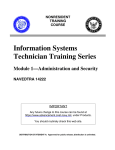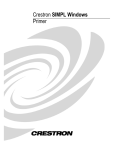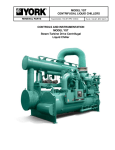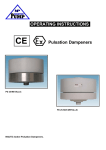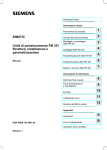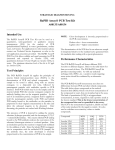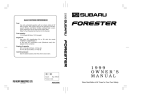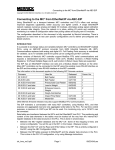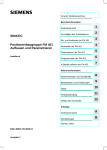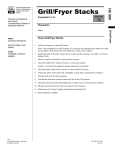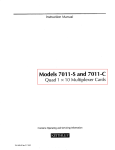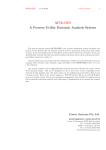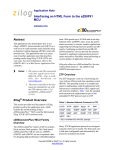Download TU-00000 TSE Manual.cdr
Transcript
PO TSE WE R MO DE HR MIN Need Help? If you need advice about any aspect of your Acticare device please email us at: UK and Europe [email protected] Australia and NZ [email protected] or consult our website www.acticare.com for support telephone numbers. Calls may be recorded for quality control purposes. Key to Symbols used in this Manual Contra-indications. These notes describe situations where you should not use Acticare TSE. Warnings and Cautions. Make sure you understand these before using Acticare TSE. Important Note. This symbol appears next to key points of note. Common problems are listed in the troubleshooting guide in section 10. R O 0120 Acticare TSE is manufactured by: Warranty information Bioinduction Limited 178-180 Hotwell Road Bristol BS8 4RP United Kingdom Bioinduction Ltd warrants Acticare TSE and its fast charge cradle free from defects in workmanship and materials for one year from the date of invoice. Tel: Website: Email: Electrodes, batteries, carry cases, lead wires and other accessories are warranted to be free from defects in workmanship or materials at the time of delivery. +44 870 241 9071 www.acticare.com [email protected] Document REF: TU-00000 TSE Manual (5.0) Part code: C00201 Year of manufacture: 2009 Acticare TSE and the Acticare logo are registered trademarks of Bioinduction Ltd The Acticare TSE device is protected by patents and patents pending. This manual is copyright © Bioinduction Limited 2004-2007. Bioinduction Ltd will repair or replace, at its discretion, any product found to be defective within the warranty period. This warranty does not apply to any product which has been damaged due to misuse, or that was repaired or altered other than by the manufacturer. Introduction 1 Important Information 2 Your Acticare TSE 3 Charging Batteries 4 Treating Yourself with TSE 5 Treating Yourself with TENS 6 Settings Menu 7 Maintenance and Care 8 Advanced Therapy Modes 9 Troubleshooting 10 Technical Information 11 Quick Reference 12 Introduction About “TSE”, “TENS” and “RF” Welcome to Acticare TSE! 1 Acticare TSE can deliver two different types of electrotherapy called “TSE”, “TENS” and “RF”. Congratulations, you have invested in an Acticare TSE device to help manage your pain without increasing your intake of drugs. If you are eager to get started, you only need follow the instructions on the enclosed “Quick Start Guide”. “TSE” stands for: Transcutaneous (through the skin) Spinal Electroanalgesia (electrical pain relief). TSE is a unique and powerful form of electrotherapy available only on Acticare devices. Acticare TSE provides effective relief from persistent pains anywhere on the body. In a January 2005 study of 150 patients who used Acticare TSE for a period of two months, more than 3 out of 4 said that they had 50% or more pain relief, despite an average duration pain of 9 ½ years. In addition to providing pain relief, TSE improves mood, relieves stress and can aid natural sleep. “TENS” stands for: Transcutaneous (through the skin) Electrical Nerve Stimulation. TENS is a commonly available form of electrotherapy used widely by physiotherapists and doctors. TENS treatments normally produce a tingling sensation and work by stimulating the peripheral nerves. TSE is an accumulative therapy and therefore it is important that you treat yourself regularly for at least a week, preferably two, before you assess your level of relief. Although TSE may reduce pain, in many cases it does not completely eliminate pain. "RF" stands for: Radio-Frequency. This is a form of TSE where the pulses are delivered in short bursts rather than individually and is similar in concept to pulsed radio frequency treatment used widely in pain clinics. Acticare TSE should only be used to treat diagnosed pains. If you have any new symptoms always consult your doctor. Also, do not vary your intake of any prescribed medication without consulting your doctor. TSE is safe to use in the home, but should not be used if you are epileptic, pregnant or have a cardiac pacemaker. Many people find that by using TSE they have good relief from pain for the first time in many years, which leads to a recovery of mobility. If this is your experience, please take care not to “overdo it” but instead ease yourself gradually back into a more active lifestyle. 1 1 Introduction The History of TSE and Acticare How Does TSE differ from TENS? Electrical stimulation of the spinal cord for pain relief dates back to 1967, when electrodes were implanted in the spinal cord to block the sensation of pain. This technique is called Spinal Cord Stimulation (SCS). Spinal Cord Stimulation is often effective against longstanding pain, but has the disadvantage that surgery is required to implant the electrodes. Transcutaneous Electrical Nerve Stimulation (TENS) is a popular and successful treatment for the relief of common aches and pains. There are however a few limitations to its use. Effectiveness may reduce over a period of time and the period of post-stimulation relief tends to be brief. Also, TENS electrodes must be placed over the painful region and correct placement often requires experimentation. In 1991, inspired by the success of SCS, Drs Alex Macdonald and Tim Coates discovered Transcutaneous Spinal Electroanalgesia (TSE). They were granted patents on the technology in 1995 and 1997. One benefit of TSE is that the electrode locations are standardised. Two surface electrodes are always placed over the spinal cord wherever the painful regions are. Because the spinal cord is the body's conduit for pain signals, TSE can relieve multiple pains in different parts of the body at once. Furthermore, the effect of TSE tends to be cumulative over time in about 50% of patients. TSE uses very short electrical pulses applied to the spinal cord via the skin. These pulses are only a few millionths of a second in duration, but of relatively high voltage. The pulses pass through the skin and tissues to the spinal cord. They are too short to cause any more than a very mild tingling sensation in nerves under the skin, so the therapy is well tolerated by most people. In order to penetrate deep tissues, TSE pulses are of higher voltage and higher power than TENS. But because of their very short duration, TSE pulses produce less stimulation of the peripheral nerves and therefore little or no tingling sensation which some patients find uncomfortable. TSE has been used as a form of electrical pain relief since its discovery in 1991. No serious side effect or interaction with medication has been reported despite being used in over 100 NHS hospitals and by thousands of patients in their homes. The Acticare TSE device looks very similar in size and shape to a regular TENS device, but its size is deceptive: under typical treatment conditions it delivers ten times the power. TSE will work alongside drug therapy without harmful interactions or side effects and is complimentary to physiotherapy, osteopathy and acupuncture. TSE has also been clinically proven to improve mood and aid relaxation. 2 1 Important Information Indications Warnings Acticare TSE is intended to be used for the symptomatic relief of chronic pains of all types, to help improve mood and aid natural sleep. Pregnancy The safety of using electrotherapy at anytime during pregnancy or birth has not been established. Drowsiness This device can cause drowsiness or light-headedness. During use, or after use if feeling drowsy, never operate potentially dangerous machinery such as power tools, automobiles, etc. Contraindications 2 Cardiac pacemakers Not to be used by persons fitted with a cardiac pacemaker. Epilepsy Not to be used by persons who suffer from an epileptic condition. Symptomatic treatment This device may suppress sensations of pain that would otherwise serve as a protection mechanism. Transthoracic Stimulation (Chest) Do not apply the electrodes across the chest. This can cause electrical current to enter the chest and may lead to irregularities in heart beat. Keep out of reach of children This device is not recommended for use on children except under clinical guidance. Cranial Stimulation (Head) Do not apply the electrodes across the head. Metallic Implants Consult a clinician before using TSE if you have a metallic implant in your spine or neck. Not recommended for use by persons with metallic rods in the spine, where these rods lie between electrode locations. Skin and vascular problems Do not apply the electrodes over infected areas of skin, skin eruptions, dermatological conditions, open wounds or damaged or broken skin or on areas of the body where there is a loss of normal skin sensation. Tumours Use only under the guidance of a clinician. Unknown Cause Do not use to relieve undiagnosed pains, until cause has been established by a clinician. Neurological damage Use only under the guidance of a clinician for persons with neurological conditions such as MS, stroke and cognitive defects. Carotid Sinus (Neck Stimulation) Avoid using any electrode placement that stimulates the carotid sinus region at the front of the neck. In rare cases, spasm of the laryngeal and pharyngeal muscles may occur when the electrodes are placed across the neck or mouth. This may be strong enough to cut off the airway causing breathing difficulty. Electronic equipment Electronic monitoring equipment such as cardiac alarms may not function properly if used simultaneously with this device. External use Only for external use. Not for internal use. 3 Important Information Warnings Adverse reactions Spinal Cord Stimulators This device is not recommended for use in persons with an implanted spinal cord stimulator. Skin irritation under electrodes This usually resolves itself within a few days. A hypo-allergenic electrode material is available for sensitive skin. High frequency Surgical Equipment Simultaneous connection of a patient to high frequency surgical equipment may cause burns at the site of electrodes and possible damage to the device. Electrode reactions can arise from high intensity stimulation or mono-phasic currents that are available in advanced modes. Use the default biphasic modes and/or reduce stimulation level. Microwave or Radio frequency sources Operation close (less than 1m) to sources of short-wave radio or microwave equipment is not recommended. Adverse reactions to electrotherapy are rare but reported cases include the following: general malaise, nausea, vomiting, dizziness, fainting, migraine or headache, epileptic seizure, eczema, tinnitus, numbness, loss of muscle tone and balance, swelling or redness. If affected, discontinue use and seek medical advice. Damage from liquids Do not allow Acticare to come into contact with water or other liquids. Do not use in the bathroom. Flammable atmospheres Do not use this device in the presence of flammable gases or liquids, such as when refueling an automobile. Limitation of Liability To the maximum extent permitted by law, Bioinduction Ltd, its subsidiaries, suppliers or resellers (collectively "Bioinduction") accepts no liability for any damages arising from the use of or inability to use the product including but not limited to indirect, incidental or consequential damages. Connections Do not connect Acticare TSE to anything other than the approved charger cradle and electrode lead wires. Uncomfortable stimulation Do not operate at a level at which the stimulation is uncomfortable; reduce the intensity to a comfortable level. In any event, Bioinduction's entire liability shall not exceed the purchase price of the product, with the sole exception of death or personal injury caused by the negligence of Bioinduction but only to the extent that applicable law prohibits the limitation of damages in such cases. The purchaser indemnifies Bioinduction from all claims arising from third parties. No curative value This device is effective for the treatment of chronic pain but has no curative value. Bioinduction will not be held liable for any loss resulting from incorrect information provided by its personnel, errors or omissions in this manual and other documentation. Long-term effects The long-term effects of of electrical stimulation have not been established. By using the product the purchaser agrees to be bound by these terms, otherwise purchasers should return the product unused within 14 days of receipt requesting a refund. 4 2 Your Acticare TSE Identifying the components of Acticare TSE Carry bag Rechargeable batteries x4 Acticare TSE Device 3 To protect your Acticare TSE during transport, we recommend that you pack the device and charger in the pockets in the bag as illustrated. Pack of 4 pads Charging cradle User manual Lead wire Features of the Acticare TSE unit Electrode connector Battery catch Operating light User display TSE MODE POWER Plus button HR Battery cover MIN On/Off button Belt clip Minus button Timer button Charger connector Front View Back View 5 Your Acticare TSE Display Symbols and Their Meaning Mode Indication Shows which treatment and the number of the preset mode the device is using: TSE Transcutaneous Spinal Electroanalgesia TENS Standard and high frequency TENS RF Pulsed radio-frequency ADV Advanced mode IFRFTENSTSE MODE ADV 0 POWER HR Battery: Indicates the amount of charge left in the batteries. Scans when charging. 10 MIN Example Screen Intensity setting: Treatment timer: Shows the intensity (voltage) setting as a percentage from 0% (off) to 100% (max). Shows the remaining treatment time in hours and minutes and in seconds for the last minute of treatment. Flashes when power output is at maximum safety limit. 6 3 Charging Batteries Charging the batteries Installing the batteries Your device is supplied with four AA rechargeable Nickel Metal Hydride (NiMH) batteries which must be installed before use. The supplied fast charge cradle provides a full charge in 2½ hours. To charge batteries, plug the device into the charger stand as shown below. Make sure you push the device fully into the cradle to ensure proper contact. An intermittent beeping means that the device is not pushed completely in. 1. Open the battery cover by squeezing the blue catch into the belt clip as shown. 4 2. Insert four new AA batteries making sure the polarity is correct. The correct polarity is indicated by symbols in the battery compartment. The battery symbol will scan to indicate that the battery is charging. If the battery is not charging check to make sure the charger is plugged in and the socket is switched on. When the batteries are fully charged the battery symbol shows full. Battery Low Battery Full Acticare TSE cannot be used for treatment when it is on the charger stand. Placing Acticare TSE on the charger stand during a treatment causes the device to switch off. 3. Close the battery cover. Check that it is secure. If the batteries are correctly installed the battery symbol will be displayed on the screen. 7 Charging Batteries Battery Lifetime Under typical operating conditions freshly charged batteries should last for 1-2 hours. The amount of charge left in the batteries is shown on the battery indicator when the device is switched on. Never attempt to recharge standard alkaline batteries. Do not plug anything into the base of Acticare TSE except for the dedicated Acticare charger stand. Typically, NiMH batteries need replacing after 6 months of continuous use although you may need to replace them sooner if you are experiencing poor performance. Using Non-Rechargeable Batteries 4 Acticare TSE can be used with AA sized alkaline batteries. You may find this useful if travelling abroad, but you should note that with the high power TSE modes, alkaline batteries may be exhausted in a couple of hours. Storing Acticare TSE If you plan to store your unit for a period of longer than a month, we recommend that you remove the batteries from the unit. This 8 Treating Yourself with TSE Getting started with TSE TSE modes Getting started with TSE is easier than TENS since there are only two electrode placements to consider. Correct electrode placement is one of the major reasons that users of TENS experience difficulties in early use. To get started, follow the steps summarised in the flowchart below and described in detail over the next few pages. 5 Acticare TSE has three standard TSE therapy modes and two burst TSE modes called “RF”. First time users should use TSE 1 therapy mode for pain relief. Acticare TSE comes set in TSE 1 mode as standard so you should not need to change these settings on first use. When the device is switched on the set mode is displayed on the screen for one second (to change TSE mode, see opposite). While treating yourself with TSE, you can continue to go about your daily routine, but because TSE can sometimes cause drowsiness we recommend that you do not drive if affected. Name Therapy Recommended For TSE 1 Normal TSE All first time users, all conditions. TSE 2 Powerful TSE Severe or longlasting conditions where TSE 1 has not helped. TSE 3 Long pulse TSE Low mood, fatigue and conditions where TSE 1 & 2 have not helped. Plug the lead wire into the top of the device and connect to two electrodes. Stick the electrodes on your skin in one of the two positions shown on page 12 depending on where your pain is. RF 1/2 Burst mode TSE Turn on Acticare TSE by pressing and releasing the ON / OFF button. Acute pain and conditions where regular TSE has not helped. Selecting treatment time and intensity Commence treatment by pressing and holding down the + button to increase the treatment intensity until you feel a light tingling sensation or reach 100%. Typical settings are 50% with electrodes on the neck and 100% with electrodes on the back in TSE 1 (the default mode). With TSE, there is no one treatment time appropriate for everybody and every condition. Because the effects of TSE tend to accumulate over time, we recommended that you use the therapy every day for two weeks before assessing the degree of relief. First time use: Start off with a 30 minute treatment using the default TSE mode called TSE 1. Set the treatment intensity so that you feel a mild tingling at first, which will usually dissipate as the treatment progresses. Treatment ends when the timer finishes counting down and the message “Treatment Complete” is displayed. 9 Treating Yourself with TSE If at the end of this first treatment you have not experienced any relief, immediately restart the treatment for another 30 minutes using a higher intensity with a continuous tingling sensation. Changing Therapy Modes. As supplied the Acticare device is set in TSE Mode 1. You can change it to any one of three TSE, six standard TENS, two High Frequency TENS (HFT) modes, two pulsed radio-frequency (RF) modes or the advanced mode (ADV) by following the steps below. A full list of preset modes is shown on page 26. Many people find that they experience relief after 30-60 minutes, with one or two sessions per day. However, you can use TSE for as long as you need to gain relief, it is not possible to “overdose”. Turn on Acticare by pressing and releasing the on/off button . Hold down the TIMER button and momentarily press the plus button at the same time. Finding the best treatment time: Pain relief with TSE is often cumulative, so in regular use it is possible for users to experiment with gradually reducing the length of repeated treatments. The display flashes “MODE MENU” as confirmation. However, if you do not have relief during a session, either increase the length of treatment by up to 30 minutes or increase the intensity. IFRFTENSTSE MODE ADV 0 POWER HR After following the above guidelines for two weeks, you should settle on a treatment time that is both effective and convenient. Long term use: A typical user experiences relief with TSE using 30 minute treatments. Some only need 20 minute treatments, whereas others with long-standing and severe pains may require 3 hour treatments. Use the or keys to cycle through the available modes. If there is no relief even using 3 hour treatments, repeat the two week schedule using the more powerful TSE mode TSE 2. If TSE 2 is ineffective, try TSE 3 or either of the RF modes. TSE 3 produces a quite strong tingling sensation because of its longer pulses and may also be applied peripherally over the area of pain like a high-powered TENS machine. 10 MIN If you see the timer screen instead of the mode menu, you did not press & together. Press to exit & try again. IFRFTENSTSE MODE ADV 0 POWER HR 10 MIN Press and hold the TIMER button for one second to exit and save the new setting. 10 5 Treating Yourself with TSE STEP 1. Connect the electrodes and lead wire Connect a pair of self-adhesive electrodes to the device using the lead wire as described below. 3. Connect the lead wire to the Acticare TSE device. Note that the connector can only be inserted into the device in one orientation. For the right orientation, match up the key shape of the connector with the key shaped hole in the device. 1. Before connecting the lead wire for the first time, pull the wires apart so that the electrodes can be positioned someway apart from one another. To do this, slide down the clear plastic sheath on the lead wire and pull apart the pins as shown in the picture. 5 3 4. When you are ready to begin treatment peel the electrodes off the backing sheet using the electrode material, not the lead wire. Pulling on the lead wire can reduce the lifetime of your electrodes. 1 2. Connect the metal pins to the electrodes while they are still on the backing sheet. 4 2 Electrode life is considerably shortened by use on dirty or oily skin; it is best to clean the electrode application area with soap and water, then rinse and thoroughly dry before each session. Do not use worn-out self-adhesive electrodes as this can cause weak stimulation and skin irritation. With normal use (one treatment per day) electrodes begin to lose their stickiness after one month. Replace with new electrodes when this occurs. 11 Treating Yourself with TSE STEP 2. Place the electrodes on your skin Place the electrodes in the locations described below depending on the site of your pain. For pains in both areas of the body, alternate the electrode placements between treatments. For all pains below the shoulders: Spinal Placement. Place one electrode at the base of the neck. Place the other electrode in the middle of the lower back as shown. Make sure that the electrodes are directly over the spine. If you are using TSE 3 for low mood, always use the spinal placement. For pains in the head, neck, upper chest and arms: Neck Placement. For TSE 1 and 2 and RF modes only, place electrodes either side of the neck as shown. There should be a hands-width gap between the electrodes. Remove any metallic necklaces when using the neck placement. Spinal Placement Neck Placement Alternate Neck Placement If you find the basic neck placement uncomfortable, try this alternate neck placement with the pads on the top of the shoulders as shown. Do not use neck placement at intensity settings that cause intense tingling sensations. Peripheral electrode placement: If you have a recent or acute injury, particularly if it is localized, you may find that you get best results with the electrodes placed so that they span the painful area, rather than using the standardized neck or back placements described above. For instance, if the pain is in your arm or leg, place one electrode directly over the point of pain and the second electrode further up the limb and on the other side, so that current flows through the tissues. Use the high power TSE2 or RF modes, as they cause little or no sensation while blocking pain signals. If you are unsure about where to place the pads you can also use TSE and RF modes with the pad placements indicated in the TENS section on pages 16-18. Never apply the electrodes across the head or chest, or to the front of the neck since this can cause breathing difficulty if the stimulation is strong enough to cause muscle contraction. Never use the Neck Placement with any TENS mode. Only use with TSE at a level at which a tingling sensation is very mild or just perceptible. 12 5 Treating Yourself with TSE STEP 3. Turn Acticare TSE on If the POWER bar flashes, this indicates the device is providing full current, which may happen at less than 100% intensity if your skin resistance is low. This is not a problem, but there is no need to increase the intensity level beyond this setting. Once you have placed the electrodes in the correct place you are now ready to turn Acticare TSE on and begin treatment 6 Press and release the ON/OFF button to turn on the device. If using TSE for the first time, we recommend TSE 1. Most people do not feel any sensation with TSE 2, so it is fine to increase the output level to 100%. You are likely to feel a light tingling sensation using TSE 1 and TSE 3. Always check that the correct mode is set when you switch on, this is displayed at the top of the screen. 5 IFRFTENSTSE MODE ADV 0 POWER HR If the sensation becomes uncomfortable, press the – key until it is comfortable again. 10 MIN Treatment mode IFRFTENSTSE MODE ADV 0 POWER HR STEP 4. Commence treatment When prompted by the message “PRESS + TO BEGIN TREATMENT”, press the plus + key to increase the treatment intensity until you feel a light tingling sensation or reach 100%. Each press of the + key increases the intensity by just 1%, holding the key down causes the intensity to increase gradually without the need for repeated presses. Intensity Level % 10 MIN Treatment Timer Typical Running Screen With TSE treatments, we recommend that you set the intensity level to a light tingling sensation or 100% if there is no sensation. Typical intensity settings are 50% with electrodes on the neck and 100% with electrodes on the back in the default mode, TSE 1. Caution. With TSE 1 and TSE 2 especially, the electrodes may get warm and/or there may be some reddening of the skin during treatment. If this happens, check that they are properly stuck to your skin and reduce the intensity by about 25%. The orange light on the top of the unit will turn on to show that the treatment has begun. The last used treatment time (or factory default of 30 mins) is also shown. The intensity is displayed as a percentage from 0-100% at the bottom left of the screen. 13 Treating Yourself with TSE STEP 5. Completion of treatment Adjusting the treatment timer Whenever you start a treatment, the Timer automatically uses the last treatment time. You can however adjust the Timer at any time before or during a treatment. Your treatment has ended when the timer has finished counting down and the message “TREATMENT COMPLETE” is displayed. The device will bleep to let you know when treatment is over. See page 9 for advice about deciding your treatment time. You can end a treatment before the timer has finished by turning off the device. To change the treatment timer, press the TIMER button to display the Timer screen. To turn off the device hold down the ON/OFF button for 1 second. After every treatment, we recommend that you return the electrodes to their backing sheet and store them in the sealable bag to prevent them from drying out. Always stick the electrodes to the correct side of the backing sheet as marked. IFRFTENSTSE MODE ADV 0 POWER HR 10 MIN Timer Setting Screen If the message “CHECK LEADS AND PADS” is displayed, check that the electrodes and lead wires are correctly connected to the device. Check also that the electrodes are properly stuck to the skin. Once electrodes have been properly connected you can increase the power to the desired level. Press + or – to increase or decrease the timer to your desired time. You can select times between 10 minutes and 3 hours, or timer off. If the timer is set to “OFF” the treatment will run until stopped manually. Press the TIMER button for 1 second to confirm your setting. Acticare TSE will go back to the Running screen with your new treatment time shown. See section 10 “Troubleshooting” for more information. 14 5 Treating Yourself with TENS STEP 1. Select the TENS mode to use To change between therapy modes: Acticare TSE has eight different TENS therapy modes as summarised in the table below. If you are using TENS for the first time it is recommended that you start with TENS1. 6 Follow the instructions on page 10. Name Type and Sensation Technical Description Recommended For TENS1 Constant tingling 100Hz, 50µS pulse width Most types of chronic and acute pain TENS2 Constant pulsing 5Hz, 200µS pulse width For chronic pains such as back pain and arthritis. Don't use on damaged muscles TENS3 Burst mode “tapping” 100Hz, 100µS pulse width, 0.1 sec bursts five times per second For chronic pains such as back pain and arthritis. Don't use on damaged muscles TENS4 Burst mode “gripping” 100Hz, 100µS pulse width, 0.5 sec bursts once per second For chronic pains such as back pain and arthritis. Don't use on damaged muscles TENS5 Modulated fast wave 100Hz, 50µS pulse width, 3 sec modulation period Most types of chronic and acute pain TENS6 Modulated slow wave 100Hz, 50µS pulse width, 6 sec modulation period Most types of chronic and acute pain TENS7 High frequency tingling 500Hz, 20µS pulse width Severe acute and chronic pains TENS8 High frequency tingling and pulsing 500Hz, 20µS pulse width 0.05 sec bursts ten times per second Severe acute and chronic pains The current therapy mode is displayed at the top of the screen. You should always check you are in the desired mode prior to treatment. 15 IFRFTENSTSE MODE ADV 0 POWER HR 10 MIN Treating Yourself with TENS STEP 2. Setup your treatment Follow the instructions for “Treating Yourself with TSE” in section 5 with the following exceptions: 4. Electrode Positioning With TENS treatments it is important to place the electrodes in the correct position depending on where you are experiencing pain. Choosing the correct electrode positioning for TENS often requires experimentation to get a good result and you may require professional advice from your doctor, physiotherapist or TENS nurse. Otherwise refer to the maps on the following pages as a starting point. 1. Treatment Time There is no one TENS treatment time suitable for everybody so it is recommended that your first treatment time is kept short, approximately 20 minutes. Once you become familiar with your response to TENS try increasing treatment periods up to 1 hour in length. Never apply the electrodes across your head or chest when using TENS stimulation. 2. Treatment Intensity Unlike TSE treatments, TENS treatments can produce a strong tingling sensation. When setting up your TENS treatment, increase the intensity until you feel a strong but comfortable level of sensation. You may need to increase the intensity during treatment to maintain the same level of sensation as your body becomes tolerant to the TENS stimulation. Electrode Placements for TENS Lower Back Pain Place electrodes either side of the spine slightly above the position of the pain. After TENS treatments you may feel a tingling sensation or numbness around the area of the electrodes. This is normal. 3. Care of electrodes Electrode life is considerably shortened by use on dirty or oily skin; it is best to clean the electrode application area with soap and water, then rinse and thoroughly dry before each session. 16 6 Treating Yourself with TENS Electrode Placements for TENS (cont) Hip Pain Place electrodes so that the painful area is between them. Shoulder Pain Apply electrodes to the front and back of the painful shoulder. Knee Pain Place electrodes either side of the knee. For best results avoid placing the electrodes on the knee cap. Neck Pain Place electrodes on the back of the neck no higher up than the nape of the neck. 6 Never place TENS electrodes on the side or front of the neck. 17 Treating Yourself with TENS Electrode Placements for TENS (cont) Arthritis of fingers and hands Place one electrode on the top of the hand and the second close to your elbow on the inside of the forearm. Elbow Pain Place electrodes either side of the elbow, one slightly above and one slightly below the joint. 6 Menstrual Pain Place the electrodes over the tummy area or across the lower back. Nausea and Travel Sickness Place electrodes on the front and back of one forearm just above the wrist. 18 Settings Menu To enter the Settings menu: Press + or – to set the value of the parameter to your desired setting. Hold down the TIMER button and momentarily press the minus – button at the same time. The display flashes “SETT MENU” for one second. To exit Settings and save your changes: Press and hold the TIMER button for 1 second. To make changes: Press the TIMER button to advance through the options until the parameter you want to change is displayed. To exit Settings without saving: Press the – and TIMER buttons together. The following parameters can be changed in the Settings Menu: Parameter Screen Name Valid Options Description Language L English, French, German Allows selection of language for help messages. Pad Detect PAD ON, OFF Disables detection of disconnection of leads and pads. This is useful for patients with hairy skin who experience false disconnect messages. Clock CLK ON, OFF Controls time and date display when the device is switched off. 7 Year YEAR 2004 - 2034 Sets year. Month MONTH Jan - Dec Sets month. Date DATE 1 - 31 Sets day of month. Hour HOUR 0 - 23 Sets current time (hours). Minute MIN 0 - 59 Sets current time (minutes). Pain diary DIARY ON, OFF For clinician use. Allows level of relief to be recorded using Visual Analogue Scale (VAS) scoring which can be uploaded for analysis. Consult www.acticare.com for details. Serial port COM ON, OFF For clinician use. Controls serial communications port. Buzzer BUZ ON, OFF Controls buzzer, disables end of treatment alarm. 19 Maintenance and Care Replacing electrodes Replacing batteries Electrodes typically have a lifetime of 30 uses. This means that they should be replaced every month if used once per day. With heavy use, or if used with oily or hairy skin, electrodes may need replacing sooner. The rechargeable Nickel Metal Hydride (NiMH) batteries installed in Acticare TSE may need replacement if the time between charges has decreased considerably. Because batteries are chemical products, performance deteriorates not only with use but also during prolonged storage. Normally, the batteries will last around 6 months (or 250 cycles) if used under proper conditions. Because of the higher current level with TSE, standard carbon rubber TENS electrodes are not suitable. Always use the recommended electrodes available direct from us. These have an integral metallic conductor for superior current distribution. Disposing of a battery in fire can cause the battery to rupture. Care of electrodes Always store electrodes on their backing sheet in their sealed bag between treatments. When not in use do not leave electrodes exposed to the air, even if on their backing sheet. This may cause them to dry out prematurely. To prevent cross contamination do not share electrodes. Replace with good quality AA size NiMH batteries of at least 1600mA/hour capacity. Never use the charger stand with non-rechargeable batteries installed. Spares Service The following spares are available from our helpline or our website: www.acticare.com. Electrode life is considerably shortened by use on dirty or oily skin; it is best to clean the electrode application area with soap and water, then rinse and thoroughly dry before each session. Dry electrodes may be re-moistened by rubbing a few drops of water into the sticky surface. Cleaning Your Acticare TSE Unit Clean the outside of the unit as required with a damp cloth. Do not use strong detergents or immerse the unit, lead wires, or electrodes in any liquid. Be careful not to force any liquid into the gaps where the buttons meet the outer casing. 20 Item Order Code Electrode Pads (pack of 4) C00207 Blue Electrode Pads for sensitive skin (pack of 4) C00220 Rechargeable batteries (pack of 4 AA size) C00200 Lead wire C00206 Long lead wire C00251 Acticare TSE carry bag C00208 Acticare TSE user manual C00201 Charger cradle: UK Version European Version North American Version Australian Version A00007 A00008 A00009 A00010 8 Advanced Warranty Therapy Information Mode Advanced Mode allows the user to control the type of the waveform generated by Acticare TSE by programming a series of parameters that describe the wave shape and frequency. This mode is very flexible, it allows the device to be configured to provide a wide range of stimulation modalities such as Neuromuscular Stimulation and Electro-Acupuncture, at frequencies from 1Hz to 500,000Hz. There are three basic forms of wave generated by Acticare: Only for use by doctors and therapists experienced in electrotherapy. The instantaneous output charge in normal operation is limited to 25µC per pulse to prevent dangerous shock. The maximum average current is also limited to 20mA. These limits are not changeable by the user. To Setup an Advanced Waveform 1. Enter the Therapy Mode menu by holding down the TIMER button and momentarily pressing the plus + button at the same time. The display will flash MODE MENU as confirmation. 1. Biphasic a square waveform with equal positive and negative pulses 2. Select advanced mode “ADV” using the + and – keys. to scroll through the 3. Press TIMER waveform parameters. Use the + and – keys to set values for each of the parameters (available parameters are shown in the table opposite). 2. Monophasic a square waveform with single positive pulses 3. Twin peak a square waveform with two repeated positive peaks 9 4. Exit the Therapy Mode menu and save your selection by pressing and holding the TIMER button. Pulse amplitude. The maximum voltage produced by Acticare TSE is 250V, but this is reduced as the programmed pulse width increases to prevent excessive levels of stimulation at longer pulse widths. The peak voltage at 100% output into 500ohms is indicated in the table. Pulse width Peak Voltage 0.5 - 2µS 3 - 5µS 6 - 10µS 20µS 50µS 100 - 200µS 250V 200V 160V 130V 90V 70V If the message “INVALID” is displayed when you exit, this means the waveform specified is not possible for Acticare TSE to produce. This may occur for one of three reasons: i. The sum of the pulse width (PULS) and inter-pulse space (SPAC) you have specified is longer than the time available at your desired frequency (FRQ). You should reduce the pulse width (PULS) or decrease the frequency (FRQ). ii. The burst time (BT) you have specified is too long for the burst frequency (BF). You should reduce the burst time or decrease the burst frequency. 21 iii. You are attempting to use waveform frequencies below 100Hz in Burst mode, this is not possible with Acticare TSE. Advanced Warranty Therapy Information Mode Basic Waveform Parameters Pulse Width Burst Parameters Waveform Frequency Burst Time Burst Frequency Pulse Amplitude Inter-pulse Spacing Available Parameters Each parameter may be independently set to produce any desired waveform. For example a 50µS Biphasic TENS pulse repeated at 250Hz with bursts of 1 sec on, and 1 sec off would require the following parameters: MODE: BIPH, PULS: 50µS, SPAC: 0µS, FRQ: 250Hz, BT: 1000mS, BF: 0.5Hz. Interpulse Spacing SPAC 0.0µS 0.5µS 1.0µS 1.5µS 2µS 3µS 4µS 5µS 6µS 8µS 10µS 20µS 50µS 100µS 200µS 1mS 2mS Waveform Burst Burst Frequency Time Freq FRQ BT BF 1Hz Off 0.25Hz 5Hz 10µS 0.5Hz 10Hz 20µS 1Hz 25Hz 1mS 2Hz 50Hz 2mS 5Hz 100Hz 5mS 10Hz 250Hz 10mS 20Hz 500Hz 20mS 50Hz 750Hz 50mS 100Hz 1kHz 100mS 250Hz 2.5kHz 250mS 500Hz 5kHz 500mS 1kHz 10kHz 1000mS 2kHz 20kHz 2000mS 50kHz Device safety limit prevents 100kHz continuous output at these 200kHz frequencies - use burst modes with short bursts. 500kHz Not valid in burst modes Pulse Width PULS 0.5µS 1.0µS 1.5µS 2µS 3µS 4µS 5µS 6µS 8µS 10µS 20µS 50µS 100µS 200µS Warning. Only use the Monophasic and Twin Peak waveforms with medical advice. These waveforms result in a net flow of current from one electrode to the other electrode. The result may be reddening or, in severe cases, burns under the electrodes due to ionic transport. Scientific Notation Hz Hertz (cycles per second) µS Microseconds mS Milliseconds µC Micro coulombs (unit of charge) Waveform time in µS = 1,000,000 ÷ Waveform frequency (FRQ) Waveform frequencies of 50Hz and below are not available for burst modes. 22 9 Troubleshooting Message / Symptom Possible causes Solution “Check Leads and Pads” on display. The electrodes are not properly stuck to the skin. Make sure that the lead wire is properly connected to both the device and the electrodes. Ensure that the electrodes are firmly stuck to the skin. Replace electrodes if required. If skin is very hairy, cut short underneath the electrodes and try again. If none of the above works, disable Pad Detect in settings (section 7). Badly connected lead wire. Very hairy skin. 10 “Low Batt”. Batteries are flat. Recharge batteries. Blank screen. Batteries are flat or not correctly inserted. Recharge batteries and check orientation. “Error 01- 02” then shutdown. Device is too warm to operate (above 60C). Allow device to cool before use. “Error 03-04-05-0608” then shutdown. Internal error. Turn device off then on. If error persists reset device (see instructions opposite). “Error 07” then shutdown. Output shorted (i.e. leads or electrodes touching) or safety limit reached. Check output lead or pads are not touching. Turn device off then on. If error persists reset device. Non-responsive or locked up display. Internal fault. Follow instructions opposite for device reset. Display does not come on even though batteries are inserted. Weak or dead batteries. Recharge batteries. Batteries installed the wrong way around. Check that batteries are inserted the right way around. Poor adhesion with skin. Check electrodes are not peeling away. Power set too high. Reduce power level by 25%. The device is operating at its current limit. This is sometimes caused by electrodes being close together. Otherwise there is no action required. The current limit is a safety feature that ensures that excess current does not flow even if your skin resistance is low. Electrodes become hot during use. Power bar flashing. 23 Troubleshooting Message / Symptom Possible causes Solution Device appears to be operating but no output. Lead wire connection. Check connectors are fully pushed home. Mode with no sensation. This is normal, it is common not to feel any sensation with pulse widths less than a few microseconds. Device in charger cradle but not charging &/or beeping continuously Very low battery. Leave overnight to slow charge. Batteries do not retain charge or battery meter goes straight from full to empty. Mains not connected. Check power socket. Batteries too hot. Allow device to cool (batteries must be less than 40C to fast charge). Device not fully home. Push fully home (until it stops beeping). Old or damaged batteries. Fit new batteries. Resetting Acticare TSE Some faults may be resolved by restoring factory settings and resetting Acticare TSE. Check that battery positive terminal alternates as illustrated 1. Restore factory settings. Start with the device off and hold the TIMER key while pressing the ON/OFF key. The device should display all segments followed by the software revision before starting up normally. 10 2. Reset Acticare TSE. Open the battery cover by squeezing the blue catch in the belt clip (refer to page 7 for detailed instructions). Remove one battery. After five seconds, replace the battery. illustrated; the symbols inside the battery case indicate correct placement. The positive end of the battery is the one with the pip and marked with a “+”. If the batteries are correctly installed the battery symbol will be displayed on the screen. If not check that the batteries are inserted with the positive terminals correct as If none of the above resolves your problem, you can email us at: [email protected], visit our website at: www.acticare.com or call our customer service line. 24 Technical Information Specifications Parameter Average current limit Maximum charge per pulse Waveform type Treatment Timer Pulse width Output frequency Power source Electrical protection rating Weight Dimensions Specification 20mA @ 250VDC bus 25µC per pulse under normal operation 75µC with single component failure Biphasic, monophasic or twin peak square wave 10 mins to 3 hours 0.5µS to 100µS 1Hz to 500kHz Four AA batteries (rechargeable NiMH 1.2V or alkaline 1.5V) Type BF equipment. Do not attempt to connect to mains power except through approved charger stand. 235gms 100x72x38mm Environmental Ambient Operating Conditions: Temperature 11 Relative humidity Atmospheric pressure Shipping and Storage Conditions: Temperature Relative humidity Atmospheric pressure All electrical specifications are +/- 10% 10C to 50C (battery charging 10C to 40C) 30-75% (non-condensing) 0.86-1.06 hPa -40C to 70C 10-100% (non-condensing) 0.50-1.06 hPa into a 500 ohm load Specification - Charger Cradle Parameter Input voltage Europe / UK / Australian Versions North American Version Output voltage Specification 230-240VAC 50-60Hz 115VAC 60Hz 6V @ 1000mA 25 Technical Information Standard TSE and TENS Therapy Mode Parameters Mode Waveform Frequency FRQ Waveform Type WAVE Pulse Width PULS Interpulse Spacing SPAC Burst Time BT TSE1 2.5kHz Biphasic 1.5µS 200µS OFF TSE2 10kHz Biphasic 0.5µS 0.5µS OFF TSE3 250Hz Biphasic 4µS 2000µS OFF TENS1 100Hz Biphasic 50µS 0µS OFF Burst Freq BF TENS2 5Hz Biphasic 200µS 0µS OFF TENS3 100Hz Biphasic 100µS 0µS 100mS 5Hz TENS4 100Hz Biphasic 100µS 0µS 500mS 1Hz TENS5 100Hz Biphasic 10-50µS 0µS 3 sec modulation TENS6 100Hz Biphasic 10-50µS 0µS 6 sec modulation TENS7 500Hz Biphasic 20µS 0µS OFF TENS8 500Hz Biphasic 20µS 0µS 50mS 10Hz RF1 500kHz Biphasic 0.5µS 0.5µS 20µS 1kHz RF2 250kHz Biphasic 0.5µS 1.5µS 20µS 2kHz See page 22 for diagrams of Waveform shapes and Burst parameters. Modulation modes produce a linear variation of pulse width between 10 and 50µS over the specified period. TSE and TENS modes - Peak Output into 500ohms Pulse width Peak Voltage 0.5 - 2µS 3 - 5µS 6 - 10µS 20µS 50µS 100µS 250V 200V 160V 130V 90V 70V 26 11 Quick Reference The Acticare TSE device has 4 buttons. Plus button Timer button On/Off button To start treatment press the button. Each press increases intensity by 1%. Hold the button down to increase quickly. The treatment intensity is displayed as a percentage (highlighted in red in the diagram below). Minus button To turn the device on press . To turn the device off press and hold one second. for IFRFTENSTSE MODE ADV 0 POWER HR 10 MIN Intensity Level % To adjust the treatment timer Press the to enter timer setting mode IFRFTENSTSE MODE ADV 0 POWER HR 10 MIN Set the treatment intensity at the level at which you first feel a slight tingle or 100%. To increase or decrease treatment intensity during treatment, press the or buttons. Each press changes intensity by 1%. Hold the button down to change quickly. Use & to adjust time 12 Press and hold for one second to save your new time. Quick Reference To stop treatment press and hold the button to quickly reduce intensity. When the treatment level reaches 0% the treatment stops automatically. Alternately, you can stop treatment by turning the device off. To change therapy mode hold down the TIMER button and momentarily press the plus button at the same time. The display should flash “MODE MENU” as confirmation. IFRFTENSTSE MODE ADV 0 POWER HR To check therapy mode turn the device on using the key. The mode is displayed at the top of the screen at all times (highlighted in red in the diagram below). IFRFTENSTSE MODE ADV 0 POWER HR 10 MIN You should always check you are in the desired mode when you turn on Acticare TSE prior to treatment. The default mode is TSE1. To restore factory settings. Start with the device off and hold down the timer key while you turn the unit on with the on/off key. The device should display all segments followed by the software revision number before starting up normally. 10 MIN If you see the TIMER setting screen this means you did not press both keys together. Press to exit and try again. Press or to select the mode you wish to use. Each press of causes the menu to cycle through the available modes in this order: 3 “TSE” modes: TSE1-TSE3 (Page 9) 8 “TENS” modes: TEN1-TEN8 (Page 15) 2 “RF” modes: RF1-RF2 (Page 9) Advanced settings mode: ADV (Page 21). IFRFTENSTSE MODE ADV 0 POWER HR 10 MIN 12 Press and hold TIMER exit and save settings. for 1 second to Quick Reference Before first use please read the warnings and contraindications contained in section 2. Key Features of Your TSE Device To treat yourself with Acticare TSE: Plug the lead wire into the top of the device and connect to two electrodes. Stick the electrodes on your skin in one of the two positions shown in the photos depending on where your pain is. Electrode connector Operating light Turn on Acticare TSE by pressing and releasing the ON / OFF button. User display TSE MODE Plus button POWER HR MIN Commence treatment by pressing and holding down the + button to increase the treatment intensity until you feel a light tingling sensation or reach 100%. Typical settings are 50% with electrodes on the neck and 100% with electrodes on the back in TSE 1 (the default mode). On/Off button Minus button Timer button Treatment ends when the timer finishes counting down and the message “Treatment Complete” is displayed. Electrode Placements for TSE For all pains below the shoulders: 12 Place one electrode at the base of the neck. Place the other electrode in the middle of your lower back as shown. For pains in the head, neck, upper chest and arms: Place electrodes either side of the back of the neck as shown. Do not use this placement in TENS mode or any mode with a strong tingling sensation. Quick reference continued inside back cover www.acticare.com

































